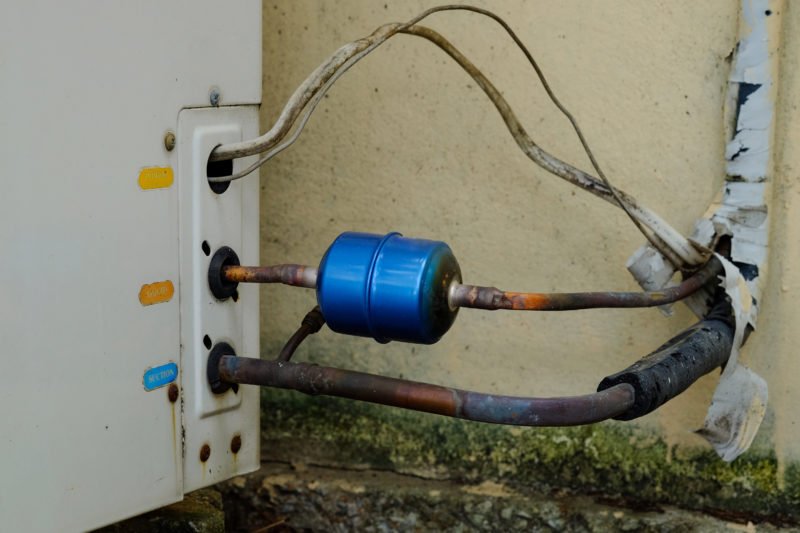What to Handle a Frozen AC Pipe - Critical Measures for Recovery
What to Handle a Frozen AC Pipe - Critical Measures for Recovery
Blog Article
Everyone seems to have their own unique theory on the subject of Have a Frozen AC Line? Here’s How to Fix It.

Introduction
Discovering that your AC pipe is frozen can be concerning, particularly throughout hot summer months when you count on your air conditioning system one of the most. Recognizing what to do in such a situation is vital to avoid additional damage to your air conditioning system and ensure your convenience inside.
Recognizing the Causes
Numerous elements can contribute to the cold of an air conditioner pipeline. Understanding these causes can help you resolve the problem properly.
Absence of Airflow
One common source of an icy air conditioning pipeline is inadequate air flow. When the air flow over the evaporator coil is limited, it can create the coil to go down below freezing temperature level, causing ice development on the pipeline.
Reduced Refrigerant Levels
Not enough cooling agent levels in your air conditioner system can likewise result in an icy pipe. Reduced refrigerant levels can cause the stress in the system to drop, bring about the cold of moisture on the evaporator coil.
Cold Weather Conditions
In colder environments, freezing temperatures outside can add to the freezing of AC pipes. If your a/c device is not correctly insulated or if there are leaks in the ductwork, chilly air can infiltrate the system, triggering the pipeline to ice up.
Dirty Air Filters
Unclean or clogged air filters can limit air movement in your air conditioner system, bring about numerous issues, including a frozen pipeline. It's necessary to replace or cleanse your air filters consistently to make certain proper airflow and avoid ice build-up.
Indications of a Frozen A/c Pipe
Acknowledging the signs of an icy air conditioning pipeline is critical for timely action.
Reduced Airflow
If you see a substantial decrease in air flow from your vents, it can indicate a frozen pipe.
Ice Buildup on the Pipe
Visible ice build-up on the cooling agent line or the evaporator coil is a clear indication of an icy air conditioning pipeline.
Strange Sounds from the Unit
Uncommon sounds, such as hissing or bubbling, originating from your air conditioning unit can signal that there's ice present on the pipeline.
Immediate Actions to Take
When faced with an icy a/c pipeline, it's important to act quickly to avoid additional damage to your cooling system.
Switching off the AC
The primary step is to turn off your a/c unit to stop the system from running and intensifying the issue.
Looking for Blockages
Inspect the area around the indoor unit for any blockages that may be blocking air flow, such as furniture or curtains.
Thawing the Pipe
You can use mild approaches like positioning towels taken in warm water around the icy pipe to help thaw it gradually.
Preventive Measures
Taking preventive measures can aid stay clear of future incidents of a frozen AC pipeline.
Regular Maintenance Checks
Schedule regular maintenance contact a specialist HVAC technician to make certain that your AC system is running efficiently.
Changing Air Filters
Routinely replace or cleanse your air filters to avoid air flow restrictions and keep optimal efficiency.
Shielding Exposed Pipes
If your AC pipes are subjected to cool temperature levels, consider protecting them to avoid cold during winter months.
Looking For Professional Help
If DIY methods fail to settle the issue or if you're uncertain about how to continue, it's finest to seek assistance from a qualified HVAC service technician.
When DIY Methods Fail
If your efforts to thaw the pipeline or address other concerns are not successful, it's time to employ a specialist.
Value of Hiring a Professional HVAC Technician
A licensed HVAC specialist has the know-how and devices required to diagnose and repair problems with your AC system securely and efficiently.
Conclusion
Handling a frozen a/c pipe can be an irritating experience, but understanding just how to respond can assist decrease damages and restore comfort to your home. By comprehending the causes, identifying the indicators, and taking punctual action, you can properly deal with the concern and avoid future events.
Frozen AC Line: Why It Happens & What To Do About It
A frozen AC line can be a rather peculiar sight in a place like Phoenix, Arizona where nothing ever freezes. In this post, we’ll discuss what makes an air conditioner line frozen – and what you can do about it.
Dirty Air Filters
Did you know that you should be cleaning or replacing your air filters on a monthly basis? Failing to do this can result in airflow issues that, in turn, cause your evaporator coils and lines to freeze over. You’ll notice a buildup of ice on both components, although the buildup on your pipes will, of course, be more evident unless you open your air condition up to reveal the coils.
What To Do About It
Give your air filter a good cleaning if it’s reusable. If not, replace the filter outright. Next, switch your air conditioner’s fan setting on and leave it there for 2-3 hours. This will draw warm air in, helping to thaw your evaporator coil. You can also check out this article for some tips on cleaning the coils themselves if you’d like to speed the process up. Before you switch the unit back to its normal state, make sure the supply vents are completely unobstructed and free of dust or other debris.
If you keep having this issue even after replacing your filters regularly, contact a local HVAC repair company and have them inspect your evaporator coil, ductwork, and any other components that may be at fault. If you live in the Phoenix, Arizona area, give American Home Water and Air a call.
Low Refrigerant Levels/Leakage
What To Do About It
Contrary to what air conditioner “recharge” companies often tell their clients about refrigerant, it should never need to be simply refilled. You see, refrigerant runs in what experts refer to as a “closed loop.” Refrigerant really shouldn’t be leaving that loop. If it is, you’ve got a leak.
Paying someone to come and pump more refrigerant into your system (aka “recharge” it) isn’t the solution. Doing that will simply kick the can down the road. Besides, refrigerant leaks can be harmful to the environment and people in your home.
Rather, you need to take care of the leak with the help of a technician. Check out this article for some more information about dealing with air conditioners that are leaking refrigerant. Before you contact a technician, switch your thermostat to the off position. Then, switch the fan setting on and let it run for 2-3 hours so the unit can thaw.
Improper Temperature Setting
Improper temperature settings can also cause a drop in your air conditioner’s pressure. What many people don’t realize is that air conditioners are actually designed to run when temperatures have fallen above roughly 60 degrees Fahrenheit. If you run the unit when it’s cold outside, you’ll run into many issues, including frozen components.

I have been very eager about What Causes AC Pipes To Freeze? and I am assuming you liked the entry. Are you aware of another person who is fascinated about the niche? Please feel free to share it. I appreciate reading our article about Have a Frozen AC Line? Here’s How to Fix It.
This Page Report this page